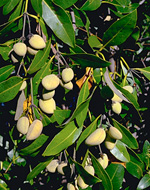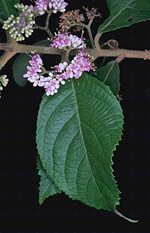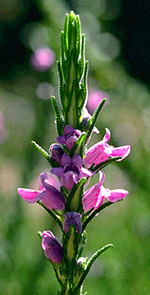 |
Most members of the Verbenaceae are tropical trees or shrubs, or sometimes lianes or herbs. One distinct group are shrubs of arid regions, while another is a mangrove that extends to the southern coast of the mainland.
Characteristic features of the family Verbenaceae in Australia include: - trees, shrubs, lianes or herbs with opposite, simple leaves, the whole plant sometimes densely covered with much-branched hairs (subfamily Chloanthoideae)
- inflorescence with bracts and bracteoles; corolla tubular, often zygomorphic and 2-lipped but also regular or almost so
- stamens 4, often in two pairs of unequal length, enclosed in or exserted
from the corolla
- fruit indehiscent, dry or fleshy, sometimes surrounded by an enlarged, brightly coloured calyx
Description
Evergreen trees, or shrubs, or woody or herbaceous vines climbing
or scrambling, or perennial terrestrial herbs. Perennating by taproots.
Stems unarmed, or rarely with prickles or spines arising from the stem
surface; internodes terete or distinctly angular. Internal secretions
not obvious. Plants glabrous, or with simple, dendritic or stellate, unicellular,
uniseriate or multiseriate hairs, sometimes with glandular hairs amongst
non-glandular ones. Leaves well developed, rarely much reduced, opposite
or whorled, rarely spiral, cauline if herbs, petiolate, subsessile or
sessile. Stipules and stipellae absent. Lamina simple or once compound,
unifoliolate, bifoliolate or ternate, symmetric, pinnatifid or pinnatisect;
lamina/leaflets filiform, acicular, subulate, linear, lanceolate, ovate,
elliptic, oblanceolate, oblong or orbicular; base cuneate, attenuate,
rounded or cordate; margins entire or crenate, ±flat, revolute
or recurved; one-veined, or the venation pinnate, with the midrib conspicuous,
and the tertiary venation reticulate; surfaces punctate or not punctate;
herbaceous or leathery; distinctive odour absent or rarely aromatic. Plants
with all the flowers bisexual. Inflorescences terminal or axillary, consisting
of capitula, glomerules, spikes, racemes, panicles, dichasial cymes or
thyrses. Bracts and bracteoles present or absent. Pollination by insects
or wind. Flowers odourless or fragrant, sessile or stalked. Floral disc
present or absent; nectaries present or absent on the disc or corolla.
Perianth of 2 dissimilar whorls. Calyx regular; segments free or fused,
with 4–8 sepals or lobes, imbricate or open in bud; calyx cup-shaped;
herbaceous. Corolla irregular or regular; segments fused, with 4–8 lobes,
alternating with the sepals or calyx lobes, imbricate in bud; corolla
funnel-shaped or salver-shaped, 1- or 2-lipped or with palate, white,
cream, yellow, orange, pink, magenta, purple, violet or blue, without
contrasting markings, or streaked, spotted, etc, membranous, papery or
succulent; claws absent; lobes ±entire. Fertile stamens 4–9, opposite
to the sepals or calyx lobes, at least partly fused to the corolla, free
of the ovary and style, distinct from each other, all ±equal or
in 2 unequal pairs. Staminodes absent. Anthers dorsifixed, versatile,
opening inwards by longitudinal slits, 2-celled; appendages absent or
rarely basal. Ovary superior and sessile. Carpels (1–) 2 or 4, fused;
ovary with 2, 4 (or 8) or rarely 1 locules. Style terminal, rarely gynobasic
or eccentric, single and unbranched, or branching from the base, or rarely
single and branched above. Ovules1–2 (rarely 4) per locule, sessile or
?stalked. Fruit dry or fleshy, a capsule with irregular dehiscence, or
a schizocarp forming mericarps; the perianth on the maturing fruit deciduous,
dry and persistent, or growing larger. Disseminule macro-surface featureless
or with straight hairs; micro-surface ±smooth, yellow, orange,
magenta, purple, violet, green, blue, grey or black, glossy or dull. Seeds
1, 2, 4 (or 8) per fruit. Aril absent. Cotyledons 2. Embryo straight.
(Note: this description has been generated from the coded data compiled for the key. Any errors in the key data will be reflected in the descriptions.)
A treatment of the family Verbenaceae has not yet been published in the Flora of Australia. It will appear in Volume 30.
Australian genera of Verbenaceae (as recognised for the Flora of Australia)
* = all species introduced
*Aloysia
Avicennia
Callicarpa
Chloanthes
Clerodendrum
Cyanostegia
Dicrastylis
Duranta
Faradaya
Glossocarya
Gmelina
Hemiphora
Huxleya
Lachnostachys
*Lantana
Lippia
Mallophora
Newcastelia
Oncinocalyx
Petraeovitex
*Phyla
Physopsis
Pityrodia
Premna
Spartothamnella
*Stachytarpheta
*Verbena
Vitex
Viticipremna

|
  |

Avicennia marina var. resinifera (fruits)
Photo: D.Jones © D.Jones

Callicarpa pedunculata (flowers)
Photo: M.Fagg © ANBG

Callicarpa pedunculata (fruits)
Photo: G.Sankowski © Zodiac Publications

Chloanthes parviflora (flowers)
Photo: M.Fagg © M.Fagg

|
 |
|